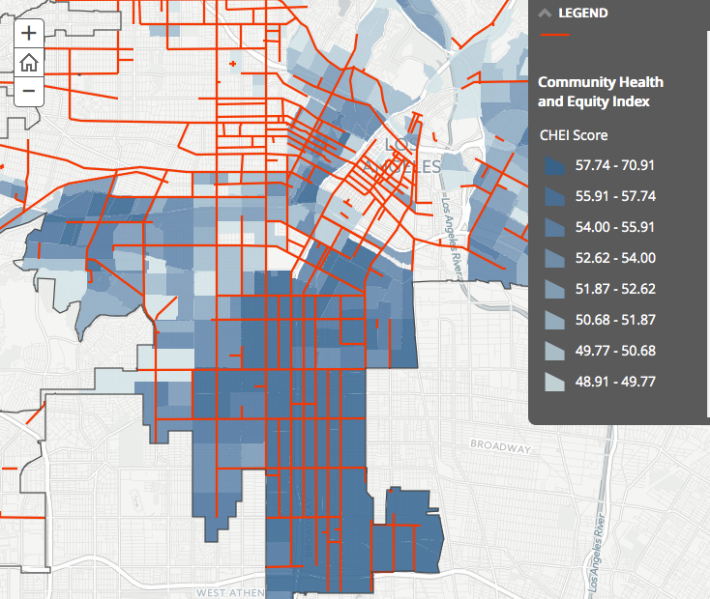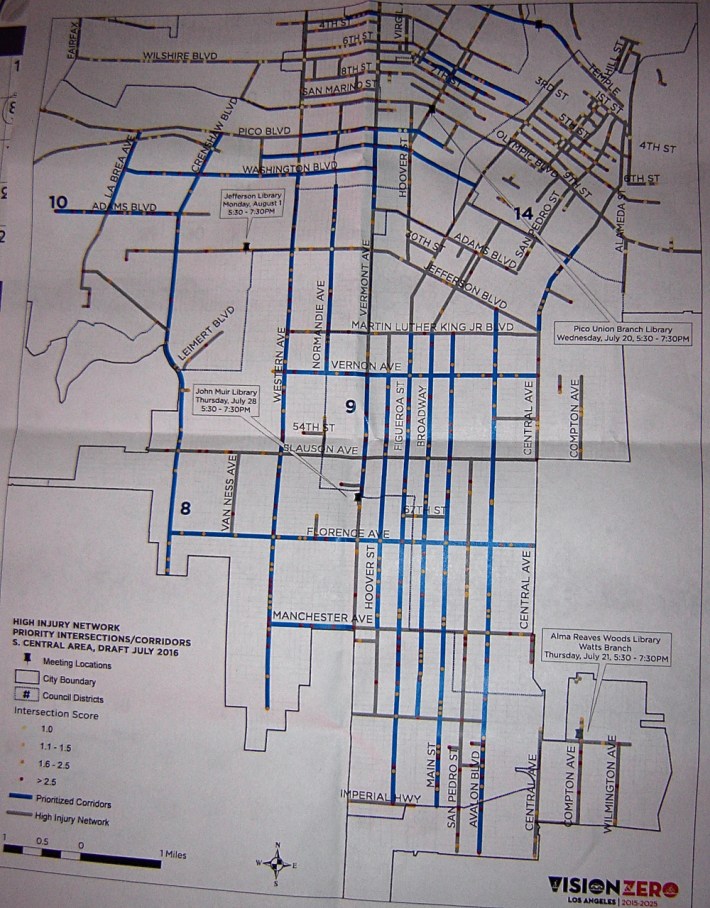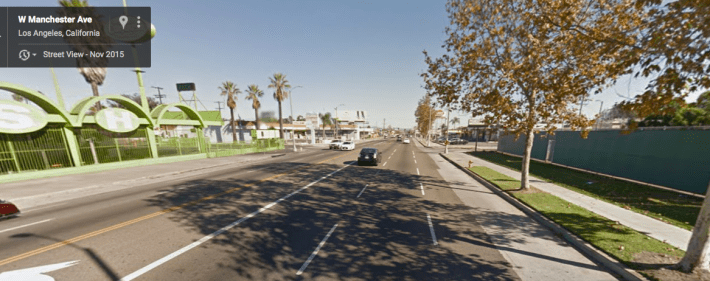Vision Zero: LADOT, Focus Group Have Same Goals, Different Ideas About How to Reach Them
3:18 PM PDT on August 2, 2016

"Remember, the end goal is to get to 20% reduction [in traffic-related deaths] by next year, and then zero by 2025," said MIG Consultant Esmeralda Garcia of the city's effort to put together an action plan to implement Vision Zero.
Gesturing toward another consultant and Brian Oh of the L.A. Department of Transportation (LADOT), she told the ten attendees (myself included) at the South Los Angeles focus group meeting last Thursday, "Anything that will help [us] to get to that goal - that's why we need to hear from you. That's why this conversation is important."
The statement made me feel very important indeed.
Then I remembered that I had not been invited to attend this gathering.
As Joe Linton noted in his coverage of Vision Zero's first real stab at community engagement, the fact that it all seems to be happening rather quietly and out of public view is both odd and very much by design. Focus group attendees were nominated by a process that still remains somewhat shrouded in smoggy mystery. And the Vision Zero Alliance (LA0) - a diverse coalition of organizations explicitly formed to partner with the city on shaping policy and communications around safe and equitable streets - appears not to have been brought on early enough in the process to play a significant role in setting up the meetings.
LADOT will likely dispute this last point, having reassured me that all proper protocols were followed with partners. Still, I think we can all agree that there are more efficient ways for the city to get feedback from its partners besides having them show up to focus group meetings at random locations around town. If only because when half of the attendees at a meeting are tied to the LA0 organizations already said to be in regular communication with LADOT, then LADOT is wasting its time getting redundant feedback while also not hearing from the wider community it is purporting to engage.
These concerns aside, the questions I found myself pondering had more to do with the purpose of the meeting and how any feedback gathered might actually be used.
To the best of my understanding, the purpose of the meeting was to support LADOT in its effort to develop an action plan governing the drive to reduce traffic-related deaths by 20 percent in the next year and a half. KPCC called the approach a "fine-tuning" of a plan that should be finished by September.
Except we were not presented with a formal plan.
Instead, we got: a) a good overview of what the crash data told the Vision Zero team; b) a look at the issues being considered and where those issues intersected with the many prioritized corridors in South Los Angeles; and c) suggestions regarding potential solutions to reduce fatalities using engineering, education, and enforcement.
Then, after each topic, we were asked for feedback: Did we get the data right? What are the highest priority traffic safety issues in your community? Will the sample solutions work in your community? What might be more effective? And, finally, how can the city "make it easier for you to engage on traffic safety?" and how can non-profits and individuals promote safety?
Those talk-back periods were where it became clear (to me, at least) that, while the city and the attendees were ultimately focused on the same outcome, they sometimes appeared to be envisioning deeply divergent ways to get there.
Thus far, LADOT has largely focused on using a quantitative data-driven approach to assessing safety. If the budget guidelines are anything to go from, that data seems to already have pushed LADOT in the direction of approximately three million dollars' worth of an educational effort to raise more awareness around Vision Zero and, more concretely, pedestrian islands, lighting, crosswalks, and other small-scale interventions at intersections to improve dangerous crossings.

Right out of the gate, however, attendees had questions about the data and the extent to which the city's framing actually fit the mobility landscape in the neighborhood.
While the combination of data collected from kill and severe injury (KSI) crashes and the factoring in of equity, children, and seniors ensured that key South L.A. corridors would be given priority, we were concerned about how well it captured the whole picture. And whether it prioritized the right corridors, or the key issues along those corridors.
For one, there is significant underreporting of collisions - even severe injury ones - in communities like South L.A. I regularly come across cyclists and pedestrians who say they have been hit at least once; although three or four times seems more the norm. I personally have witnessed or rolled up on the aftermath of several collisions between cars and bicyclists or pedestrians. And, minus the arrival of law enforcement at the scene of a crash I came upon in Silver Lake (back when I called crashes "accidents"), none of the other incidents were reported - not even those where the victim ended up in the hospital.
That underreporting may be why Avalon Boulevard was labeled a prioritized corridor while Central Avenue was listed only as being on the High Injury Network, for example. Were unreported collisions factored in along with the fact that Central is a lifeline to a far greater number of cyclists and pedestrians than Avalon, it might rank as a higher priority street.
For another, there are the collisions that don't happen because people choose driving over biking and walking.

A local resident - the only attendee who was neither nominated to attend nor linked to the planning community - told me his elderly mother was frustrated that she could not walk across Manchester Avenue to get to St. Andrews park. The traffic was so daunting that she generally resorted to driving the handful of blocks just to be able to cross the busy intersection safely. At which point she would often just drive on west to a bigger park in Inglewood, he said, since she was already in the car (and could avoid having to cross Manchester that way, too).
In short, a street can be so daunting to navigate on foot, particularly for elders, the disabled, or families with small children, that it effectively limits the number of potential pedestrian crashes by encouraging driving. Could we see how the data looked when it was overlaid with crosswalks and other information that might give us a better picture of these sorts of access issues and street users in the area? Would observation be used to corroborate quantitative data to ensure the range of needs were fully captured and solutions were appropriate? Would LADOT be spending time on the corridors selected, getting to know the community, the larger community context, and the mobility patterns of its diverse residents? And would be there some effort to improve the quality of the data?
Brian Oh reassured attendees that LADOT understood the data was imperfect and was looking at ways to improve data collection (such as working with paramedics to capture injuries and deaths resulting from collisions). We were also told LADOT was cognizant that imperfect data meant harder-to-capture dynamics remained elusive but were by no means insignificant.
LADOT could eventually take measures to make those non-prioritized streets safer, Garcia said. Given the mandate to reduce fatalities before 2018, however, it was likely those issues wouldn't be addressed until later phases of the implementation.
The action plan, Oh reminded attendees, was just phase one of a multi-year process.
All of which makes sense perfect sense, from a bureaucracy's perspective.
But for Vision Zero to be both successful and sustainable over the long haul, it will ultimately require behavioral change. That sort of shift requires cultural change and community buy-in.
Thus, from a disenfranchised community's perspective, it is never too early to begin to build the foundation of trust needed for messages to even be received in the first place. This is especially true in communities where the city has not upheld its promises in the past and where improvements can spark suspicions about impending gentrification.
Design and engineering matter, of course, and attendees saw these sorts of solutions as infinitely preferable to an enforcement approach, which attendees agreed would further tax an overly burdened community and be "trust-breaking," as Niki Wong of Redeemer Community Partnership put it.
But as more than one speaker reiterated, South Los Angeles is a community that has long been denied improvements. Any entrance the city considers making into the community must be taken as an opportunity for the city to re-introduce itself to residents, work with them to discern which improvements will fit their needs best, and build partnerships that will serve all parties down the line.
Wong, Adriana Mendoza of the AARP, and resident James Harris suggested piggy-backing off local community events and ticked off a list of organizations the city could begin to connect with to jump start that process.
Malcolm Harris of TRUST South L.A. recommended the city go one step further and put themselves in the community's shoes.
"If I wasn't in this work, I wouldn't have been thinking about [traffic safety]," he said. There are too many other things going on - too many other pressing issues impacting residents' lives.
Messaging around Vision Zero, he continued, would therefore need to be connected to real issues people were living - overpolicing, access to jobs, fear of displacement, etc.- so the information doesn't get shut down or ignored. "The typical marketing I see is more for the average person over on the Westside...who has the choice [to ride their bikes]. Not someone who is struggling and who only has a Tap card or their bike." Or for whom mobility is tied up in housing affordability, public safety, family obligations, and/or the kinds of work or school schedules they are juggling.
In that vein, I would argue, any engagement should also be more active and take into account what residents already know - how they move and how they already think about safety. People who are largely dependent on walking, biking, and transit to get around are generally pretty sensitive to the environments they move through. They may not know all the formal rules of the road, but they have little choice but to be hyper-aware of what is going on around them. Not being drivers themselves, however, they may not have a sense of how easy or hard it is for drivers to see them (especially at night), to anticipate their movements, or to react in time to avoid a collision. Participatory work with youth - engaging them on how to conduct observations, survey their neighbors, run simulations, synthesize data, draw conclusions, and/or formulate solutions - may mean safer kids now and more conscientious drivers in the future.
Whether we will see this kind of targeted, community-specific, and relationship-building approach in either the short or long term remains to be seen. Right now, Garcia told attendees, LADOT has "an ongoing consultant...that is putting together a marketing and education campaign [focused on how the city can] best promote and bring awareness to Vision Zero and all the issues that are happening."
"There is definitely going to be an emphasis on [messaging to] the people that are in cars," she said. "But there are also going to be [messages targeting] shared responsibility..." (distracted walking, unsafe behaviors by pedestrians or cyclists, etc.).
They expect to have the campaign ready to launch by the end of the year and, to that end, have already put together an education and outreach strategy.
As the meeting wound down, several of the attendees reiterated the importance of knowing the community before presuming to plan for it or construct campaigns targeting it.
When the question was put to attendees about how LADOT could reach out to folks with limited mobility, James Harris turned the question back on the facilitators.
"How would you meet them? You're asking us, but you should be asking them. I have different issues."
Picking up on a phrase a few of us had already used that night, he encouraged LADOT to "meet folks where they are" - go to churches, food giveaways, senior centers, community fairs - and to be prepared to listen.
Oh was quick to let attendees know LADOT understood the importance of this approach.
He acknowledged LADOT had learned a lot from past mistakes, when I raised concerns about the way improvements had been implemented along Cesar Chavez Avenue in Boyle Heights. [The project was said to be part of a community-driven Great Streets program, but the community was left in the dark about what was happening on their main commercial corridor until well after the improvements had begun to go in. See here, here.]
"We're not going to go in...and put in treatments that aren't for the community," Oh said. "We will be back to do the outreach. We've learned from...going in and thinking that we know what is best for certain communities."
By the power definitely not vested in me, I hereby nominate you to attend one of the remaining focus group meetings, if you're curious to learn more about Vision Zero.
- Tuesday 8/2 – Palms Rancho Park Library at 2920 Overland Avenue, Los Angeles, CA 90064
- Wednesday 8/3 – San Pedro Library at 931 S. Gaffey Street, San Pedro, CA 90731
- Tuesday 8/9 – Alma Reeves Woods Branch Library at 10025 Compton Avenue, Watts CA 90002
- Wednesday 8/10 – Pico Union Branch Library at 1030 S. Alvarado Street, Los Angeles, CA 90006
Sahra is Communities Editor for Streetsblog L.A., covering the intersection of mobility with race, class, history, representation, policing, housing, health, culture, community, and access to the public space in Boyle Heights and South Central Los Angeles.
Stay in touch
Sign up for our free newsletter
More from Streetsblog Los Angeles
Automated Enforcement Coming Soon to a Bus Lane Near You
Metro is already installing on-bus cameras. Soon comes testing, outreach, then warning tickets. Wilshire/5th/6th and La Brea will be the first bus routes in the bus lane enforcement program.
Metro Looks to Approve Torrance C Line Extension Alignment
Selecting the relatively low-cost hybrid alternative should help the oft-delayed South Bay C Line extension move a step closer to reality




